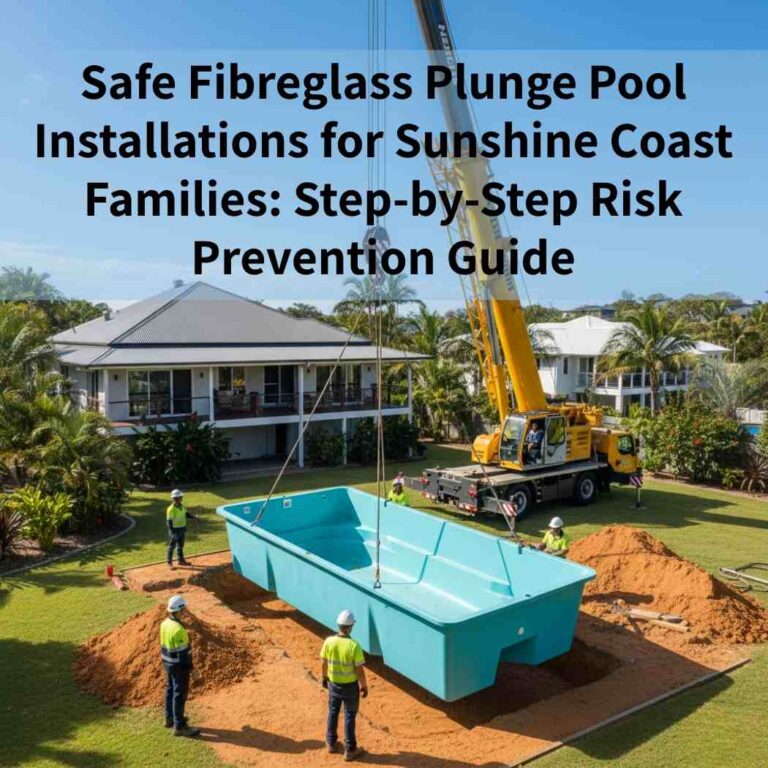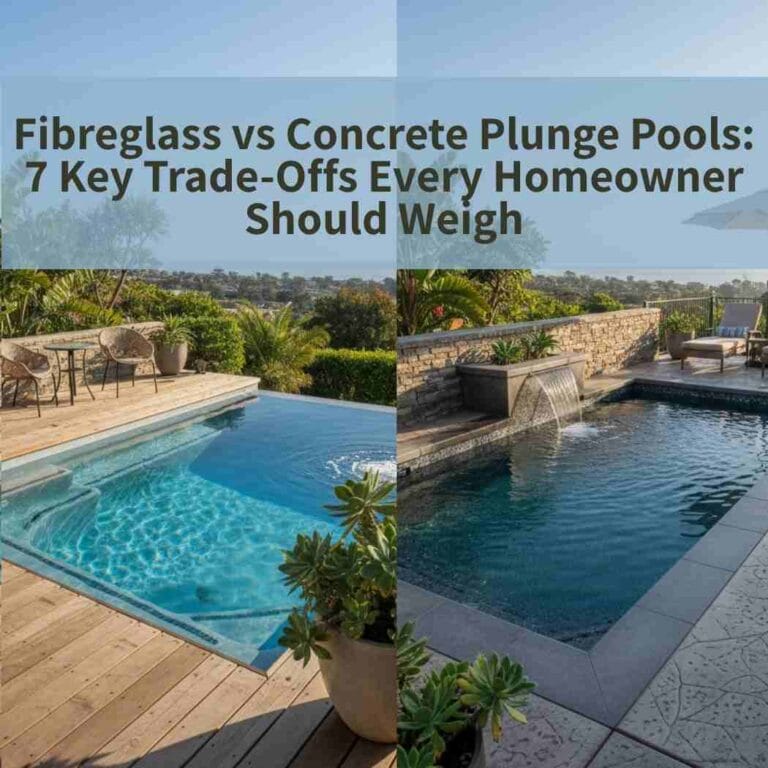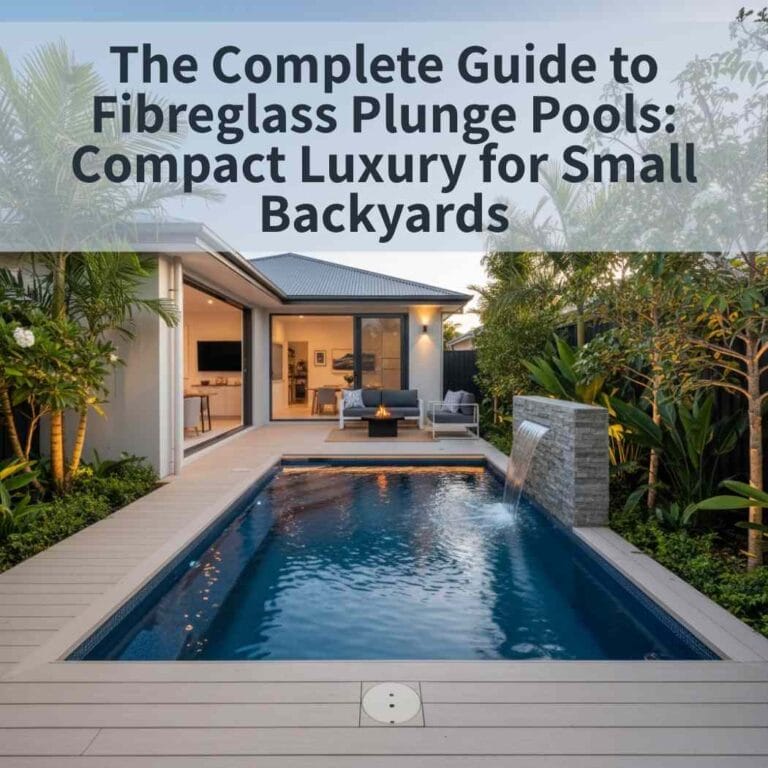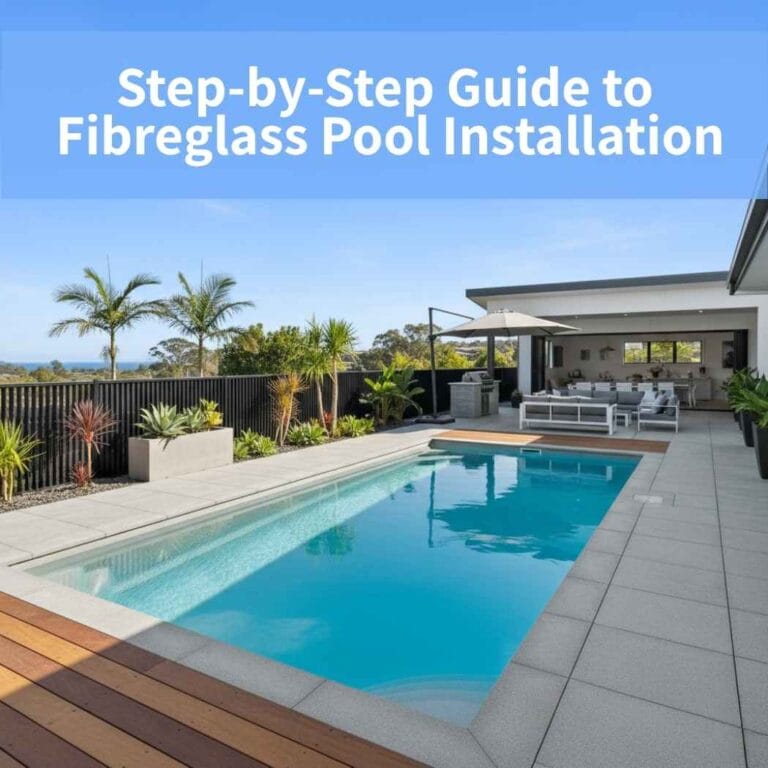At Plunge Pools Sunshine Coast, safety comes first. Our licensed team follows Queensland pool safety laws and QBCC standards on every job. We understand the local challenges of the Sunshine Coast from sandy coastal soils to steep residential blocks and plan each step to keep your site safe and compliant.
In this guide, we’ll walk you through each risk area during installation, explain how to prevent issues before they start, and show you what to check before handover. By following these steps, you’ll know your new fibreglass plunge pool is safe, secure, and ready for years of family fun.
Table of Contents
ToggleRisk Area #1: Site Access & Excavation in Coastal Soils
Why It Matters
Many Sunshine Coast properties sit on loose or sandy soil that shifts easily when disturbed. During excavation, this type of ground can collapse, wash away, or move under pressure, creating safety hazards for workers and risking future pool movement. Poor soil support also increases the chance of cracks in paving or nearby structures once the pool is filled.
Cost and Site Factors
Stabilising coastal soil usually adds $500–$1,000 to your preparation budget, but it’s worth every dollar. Proper support using geo-fabric layers, retaining boards, or temporary shoring prevents walls from caving in and keeps the excavation stable during rain or vibration. Sites on steeper slopes may also need extra soil compaction or engineer sign-off before work starts.
Common Risks
- Collapsing excavation walls or unstable trenches
- Shifting sand beneath the pool base
- Machinery damaging fencing or underground services
- Open trenches left exposed to children or pets
Preventive Measures
| Step | Action | Verification |
|---|---|---|
| 1 | Install temporary fencing before excavation | Safety barrier check complete |
| 2 | Compact sand or install retaining boards | Verified by soil engineer |
| 3 | Assign one machinery access route | Daily inspection log updated |
Acceptance Criteria
- Slope ratio no steeper than 1:1.5 for sandy or coastal soil
- Temporary fencing and safety signage in place before excavation begins
- Machinery routes inspected and logged daily for erosion or soft spots
Professional Tip
Always confirm that your installer keeps daily site inspection records and that soil stabilisation is approved by an engineer or geotechnical specialist. This not only reduces risk but also protects your warranty and insurance coverage later.
Risk Area #2: Crane Delivery and Placement Hazards
Why It Matters
Many Sunshine Coast blocks are narrow or sit close to neighbouring homes, which means a crane lift is often needed to lower the fibreglass shell into place. This stage carries higher safety risks because the lift involves heavy machinery, power lines, soft ground, and limited space. If not handled properly, a single mistake could damage the pool shell, nearby property, or even cause injury.
Duration and Site Conditions
Crane setup and placement usually take 2–4 hours, depending on how easy it is to access the site and where the crane can park. Lifts done from the street may need Sunshine Coast Council road closure permits and traffic control approval. The crane’s stability also depends on soil bearing capacity soft or sandy soil may require outrigger pads, timber mats, or ground compaction before the lift begins.
Common Risks
- Crane tipping or sinking on unstable soil
- Pool shell swinging near overhead power lines or trees
- Public access inside the exclusion zone
- Lack of proper ground tests or operator licences
Preventive Measures
| Step | Action | Verification |
|---|---|---|
| 1 | Conduct a ground bearing test | By a qualified soil engineer |
| 2 | Obtain Sunshine Coast Council road closure permit (if lifting from the street) | Council approval |
| 3 | Maintain a 10 m exclusion zone | Site supervisor confirms signage |
Acceptance Criteria
- Outriggers are fully extended and supported on stable ground
- Exclusion zone barriers and warning signs are visible around the entire lift area
- Crane operator and dogman both hold valid HRWL cards
- No unauthorised persons within 10 m of the lift zone during operation
Professional Tip
Always ask your installer for the lift plan and crane safety log before work starts. A reputable installer should provide engineer sign-off, soil test results, and a copy of the operator’s licence. These records confirm that every lift meets Queensland Work Health and Safety requirements and protect you from future liability.
Risk Area #3: Shell Levelling and Backfill Compaction
Why It Matters
Getting the pool shell level is one of the most important parts of a safe fibreglass plunge pool installation. Even a small uneven spot can cause the pool to shift, crack, or “float” after heavy rain. When a pool lifts or moves, it can damage plumbing lines, paving, and surrounding structures, problems that are expensive to fix and easily avoided with proper preparation.
What It Means
Backfill compaction means packing the soil, sand, or gravel tightly around the outside of the fibreglass shell. The goal is to stop the pool from moving once water pressure and soil weight start balancing each other. This process should always be done while filling the pool with water so the weight remains even on both sides.
Common Risks
- Pool shell not sitting level on the base
- Air pockets forming under or beside the shell
- Soft backfill or poor drainage causing shell movement
- Missing or incomplete compaction certificate from the installer
Preventive Measures
Follow these key steps:
- Check the base: Make sure the excavated base is flat and stable before lowering the shell.
- Use a laser level: Confirm alignment as the shell is positioned and again after each backfill layer.
- Add water gradually: Fill the pool with water as backfill is added to keep the pressure balanced.
- Select the right material: Use a flowable backfill mix designed for sandy or coastal soil conditions.
- Inspect throughout: Keep a daily record of compaction and stability tests until the backfill is complete.
Acceptance Criteria
- Level variance no greater than ±5 mm across the pool
- Backfill compacted evenly to the required density and signed off by a qualified engineer or installer
- No movement or lifting detected during the water-fill test
- Compaction certificate provided at handover and stored for warranty purposes
Professional Tip
Before final payment, ask your installer for a copy of the compaction certificate and laser-level readings. These prove that the shell sits perfectly and that the soil around it was properly compacted. A well-levelled pool doesn’t just look better, it also lasts longer and saves you from costly structural repairs in the future.
Risk Area #4: Electrical and Plumbing Safety During Works
Why It Matters
Electrical and plumbing work during pool installation carries serious safety risks, especially in humid and coastal areas like the Sunshine Coast. Salt in the air can speed up corrosion, while wet soil and exposed wiring increase the chance of short circuits or leaks. That’s why every connection, conduit, and fitting must be installed and tested by licensed trades before being buried or backfilled.
Local Standards and Compliance
All electrical work must follow the AS/NZS 3000 Wiring Rules and be carried out by a QBCC-licensed electrician. Likewise, all plumbing connections from the skimmer box to filtration lines must be completed by a QBCC-licensed plumber. Both trades are required to test and log their work before sign-off to meet Queensland safety and insurance standards.
Common Risks
- Exposed or unprotected wiring near damp soil
- Non-weatherproof fittings that corrode over time
- Hidden leaks under the pool base or garden area
- Power outlets or switches installed below the legal height
Preventive Measures
| Step | Action | Verification |
|---|---|---|
| 1 | Use a QBCC-licensed electrician and plumber | Licence check |
| 2 | Install weatherproof conduits and isolation switches | Visual check |
| 3 | Pressure test plumbing for 30+ minutes | Test report logged |
Homeowner Verification Checklist
Before the backfill or paving begins, make sure:
- Weatherproof switches are at least 1.2 m above ground
- Power cables run through sealed conduits and are clearly marked
- Plumbing has passed a pressure test with no drop in reading
- Licensed trades have issued compliance certificates
Acceptance Criteria
- All electrical work complies with AS/NZS 3000
- No visible leaks in plumbing lines during pressure test
- All conduits and fittings are sealed against moisture
- Isolation switch accessible and weather-rated (IP56 or higher)
- Compliance certificates filed before final inspection
Professional Tip
Ask your installer for copies of the electrical and plumbing compliance certificates before the site is covered. Early testing costs little but can prevent major repairs later. Electrical or plumbing rework after installation may cost $1,000 or more, so confirming compliance now saves time, money, and stress in the future.
Risk Area #5: Coping, Decking, and Edge Stability
Why It Matters
The pool edge is where family and friends spend the most time, so it needs to be strong, stable, and slip-resistant. If coping or decking materials are not properly installed, they can loosen, shift, or become slippery when wet leading to falls, injuries, or long-term structural damage around your pool.
Watch out for:
- Slippery tiles or glazed surfaces
- Poor drainage that allows water to pool near the edge
- Loose coping stones or uneven joins
Recommended Materials and Finishes
Choose P5 slip-rated coping tiles or textured concrete pavers for better grip in coastal conditions. Composite decking is another safe choice, as it resists swelling and fading in the Sunshine Coast’s humid air. Always use non-glazed, matte finishes around wet zones, and ensure sealants are suitable for saltwater environments.
Common Risks
- Cracked or shifting coping due to poor adhesive bonding
- Drainage slope not directing water away from the pool
- Gaps wider than 5 mm between coping joints
- Sharp edges or raised corners near steps and seating areas
Preventive Measures
| Step | Action | Verification |
|---|---|---|
| 1 | Use P5 slip-rated tiles or decking surfaces | Product slip-rating certificate |
| 2 | Apply flexible adhesive and grout rated for outdoor wet areas | Checked by installer |
| 3 | Maintain a drainage slope of at least 1:100 away from pool | Measured with level |
| 4 | Seal all edges and expansion joints with UV-resistant sealant | Visual inspection log |
| 5 | Inspect coping for level and alignment before final handover | Site supervisor approval |
Acceptance Criteria
- Drainage slope ≥ 1:100 away from pool edge
- Coping joints ≤ 5 mm and evenly sealed
- All surfaces rated P5 slip-resistant under Australian Standards
- No loose tiles, cracked grout, or movement detected after curing
Homeowner Maintenance Tip
After installation, inspect the pool edge every few months for loose tiles or early signs of cracking. Clean sealed joints gently avoid high-pressure washers that can strip sealant. If you’re adding furniture or glass fencing later, make sure anchor points don’t pierce the waterproofing or affect coping stability.
Professional Tip
Ask your installer to provide the product slip-rating certificate and details of the adhesive and grout system used. These small documents prove that your pool surround meets Australian safety standards and protect your warranty if issues appear later.
Risk Area #6: Temporary Safety Barriers During Installation
Why It Matters
A pool site without barriers is a serious safety risk and a breach of Queensland Pool Safety Regulations. Temporary fencing protects children, pets, and the public from accidental entry during construction. It must stay secure from the time excavation begins until the final Form 23 Pool Safety Certificate is issued. Even short gaps or damaged panels can lead to accidents or fines for non-compliance.
What Temporary Fencing Means
Temporary safety barriers are lockable, movable fences that enclose the pool area during installation. They’re required by law under the Building Act 1975 (Qld) and must meet the same height and gate requirements as permanent pool fencing.
Common Risks
- Unsecured gates or panels removed during construction
- Fencing that’s too low or missing self-closing latches
- Poor anchoring on soft or uneven ground
- Daily checks not recorded in the site log
- Barriers removed before the final safety inspection
Preventive Measures
| Step | Action | Verification |
|---|---|---|
| 1 | Install lockable temporary fencing immediately after the pool shell is placed | Visual inspection by site supervisor |
| 2 | Fit a self-closing, self-latching gate that opens outward from the pool | Gate test recorded |
| 3 | Inspect the fencing daily for movement, gaps, or loose panels | Daily log entry signed |
| 4 | Maintain a clear 900 mm non-climbable zone around the fence | Compliance checklist |
| 5 | Keep the barrier in place until the Form 23 certificate is issued | Final inspection approval |
Acceptance Criteria
- Fence height ≥ 1.2 m around the entire pool area
- Gate latch positioned ≥ 1.5 m above ground
- No gaps greater than 100 mm under or between panels
- Fence checked and recorded daily until permanent fencing is installed
- Barrier remains in place until final compliance approval
Homeowner Verification Checklist
Before leaving the site each day:
- Confirm the gate is locked and self-closing
- Check for loose panels, missing bolts, or tilted posts
- Record inspections in the daily log
- Report any damage or movement to your installer immediately
Professional Tip
Your installer should coordinate with a licensed pool certifier early in the project to ensure temporary fencing meets Queensland standards. Keep photos and inspection logs these serve as proof of compliance if council officers conduct a site check. Never allow the fencing to be removed, even briefly, until the Form 23 Pool Safety Certificate is officially issued.
Risk Area #7: Post-Installation Handover and Certification Delays
Why It Matters
Even after your pool looks finished, it isn’t legally ready to use until all safety checks and paperwork are complete. Missing certificates, late inspections, or incorrect forms can delay approval, trigger council penalties, or affect your home insurance. The handover stage is where everything is finalised from safety testing to warranty paperwork, so proper planning is essential.
Certification and Timeframe
The final safety inspection is usually carried out by a licensed pool certifier within 1–2 weeks after completion. Once your site passes inspection, the certifier issues a Form 23 Pool Safety Certificate, confirming that your pool meets all Queensland pool safety standards. Expect to pay around $200–$400 for the inspection and certification, depending on your location and the size of the project.
Common Risks
- Certification delayed due to missing or incomplete documents
- Fencing, electrical, or plumbing certificates not submitted on time
- Builder failing to organise the certifier before project handover
- Homeowners using the pool before receiving official approval
Preventive Measures
| Step | Action | Verification |
|---|---|---|
| 1 | Book a licensed Sunshine Coast pool certifier before the final fill | Booking confirmation |
| 2 | Prepare all required documents — Forms 16 and 23, fencing and electrical certificates, and QBCC licence copies | Document checklist |
| 3 | Conduct a homeowner walkthrough before making final payment | Site completion form signed |
| 4 | Store all certificates and warranty details digitally for easy access | Shared folder verified |
| 5 | Confirm builder has provided a maintenance and safety manual | Copy received by homeowner |
Acceptance Criteria
- Form 23 Pool Safety Certificate issued and filed with council records
- Form 16 trade certificates completed by licensed contractors
- Fencing, electrical, and plumbing compliance documents attached
- Builder provides warranty terms and owner’s safety manual
- All digital copies stored securely for future reference
Homeowner Verification Checklist
Before signing off:
- Confirm all inspection forms (16 and 23) are complete
- Make sure every trade has provided compliance certificates
- Review safety fencing and gate function one last time
- Save all digital copies in a labelled folder for insurance and council access
Professional Tip
A good installer will schedule the certifier inspection before final handover so you’re not waiting weeks for approval. Always ask for the certifier’s details and keep their report for your records. Delays at this stage are preventable, clear communication between the homeowner, builder, and certifier ensures your new fibreglass plunge pool is safe, approved, and ready for use without any legal or insurance issues.
Conclusion
Every safe pool starts with a safe build. From soil tests to crane lifts and certification, each step keeps your family protected. When done right, your fibreglass plunge pool will stay strong, stable, and compliant for years to come.
At Plunge Pools Sunshine Coast, we follow Queensland pool safety laws, QBCC standards, and local council rules on every project. Our licensed team handles everything from excavation to final certification so your pool is safe, compliant, and worry-free.
Contact us today to book your licensed, safety-checked fibreglass plunge pool installation and enjoy a pool that’s built to Australian standards and ready for safe family fun.
FAQs
How can homeowners confirm that their chosen fibreglass plunge pool installer is fully licensed and insured in Queensland?
Check the installer’s details on the QBCC licence register. It shows their licence class, expiry date, and insurance status. Always ask for public liability insurance proof before signing any contract.
What should I do if my pool site fails a compaction or safety inspection during installation?
Pause work immediately and request a rectification plan. This may involve extra soil stabilisation or drainage improvements, reviewed by an engineer or certifier before work continues.
Are there specific crane sizes or weight limits for pool lifts in Sunshine Coast residential areas?
Yes. Cranes must comply with Sunshine Coast Council permits and have a valid High Risk Work Licence (HRWL). Larger lifts from the street may need road closure and traffic control.
How long does it usually take to complete all safety inspections and receive the final Pool Safety Certificate (Form 23)?
Most homeowners get certification within 1–2 weeks after final inspection, provided all documents (fencing and electrical compliance) are ready.
What happens if my temporary fencing or safety barriers are damaged during installation?
They must be repaired or replaced immediately. The homeowner or builder is responsible for keeping barriers safe under the QLD Pool Safety Regulation until final approval.
Can weather conditions like heavy rain or coastal winds delay the fibreglass pool installation process?
Yes. Heavy rain or wind can delay excavation, crane lifting, or backfilling. Always allow flexibility in your installation timeline, especially during the wet season.




